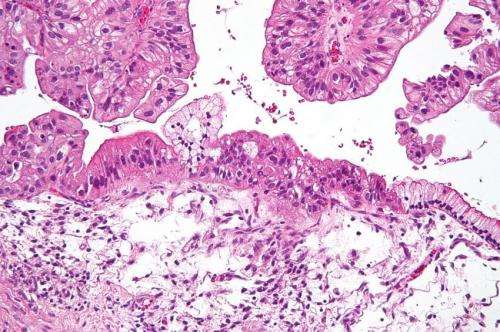
In a paper published in the journal Cancer Research, professor Levi Waldron, post-doctoral fellow Ludwig Geistlinger, and colleagues at the Institute for Implementation Science in Population Health (ISPH) at the CUNY Graduate School of Public Health and Health Policy (CUNY SPH) provide new insights into how ovarian cancer grows and evolves within a person.
The paper, “Multi-omic analysis of subtype evolution and heterogeneity in high-grade serous ovarian carcinoma” is of basic scientific interest for its methodology and insights into the decades-long process of tumorigenesis, and of practical interest for the implications these insights have on the viability of subtype-targeted therapies. More than 20,000 women receive a new diagnosis of ovarian cancer each year in the United States, and approximately 14,000 die each year.
“Understanding how a heterogeneous tumor evolves prior to diagnosis is difficult because we can’t directly observe that evolution,” says Professor Waldron. “But by observing tumors identified at different stages of that evolution, and through detailed investigation of tumor genomics and heterogeneity, we can still learn something about it. The key thing we wanted to know was whether a tumor starts as a certain subtype and stays that way, or evolves, changes, and even multiplies subtypes over time. If subtypes can evolve and multiply within one tumor, then subtype-specific therapies are unlikely to help.”
To answer these questions, the team developed a new method of inferring the existence of heterogeneous subtypes from complementary types of genomic data, published separately in the Journal of Clinical Oncology—Clinical Cancer Informatics, and teamed up with researchers from the University of Minnesota who leveraged new technology to sequence the RNA of single cells.
“We used complementary but completely different approaches to approach the same question—one using more traditional approach using DNA and RNA sequencing of hundreds of bulk tumors, and the other using new single-cell sequencing methods for a few tumors,” Waldron elaborates, “Seeing a consistent picture from both approaches really strengthened confidence in results coming from two novel approaches.”
A surprising outcome of the research is a dismissal of the idea of discrete transcriptome subtypes for this cancer, and replacement by a model of continuous tumor development that includes mixtures of subclones, accumulation of mutations, infiltration of immune and stromal cells in proportions correlated with tumor stage and tissue of origin, and evolution between properties previously associated with discrete subtypes.
Source: Read Full Article
